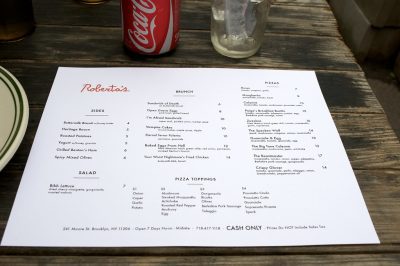All photos by Scott Lynch
Noma co-founder Mads Refslund opens Ilis in Greenpoint
The superstar chef behind ‘the world’s best restaurant’ gives Brooklyn the city's most thrilling new eatery of the year
Mads Refslund, the acclaimed Scandinavian chef who, 20 years ago, co-founded Copehagen’s Noma with René Redzepi, probably could have opened any sort of restaurant that he wanted, in almost any place in the world.
He ultimately settled on a gorgeous old rubber factory warehouse, in a space attached to the Faurschou gallery, at 150 Green Street, near Manhattan Avenue, for his new venture. Ilis will open here on October 11, with Resys coming available the day before. Refslund himself lives in Bushwick these days, but he spent several years in Greenpoint before that and fell in love with the area.
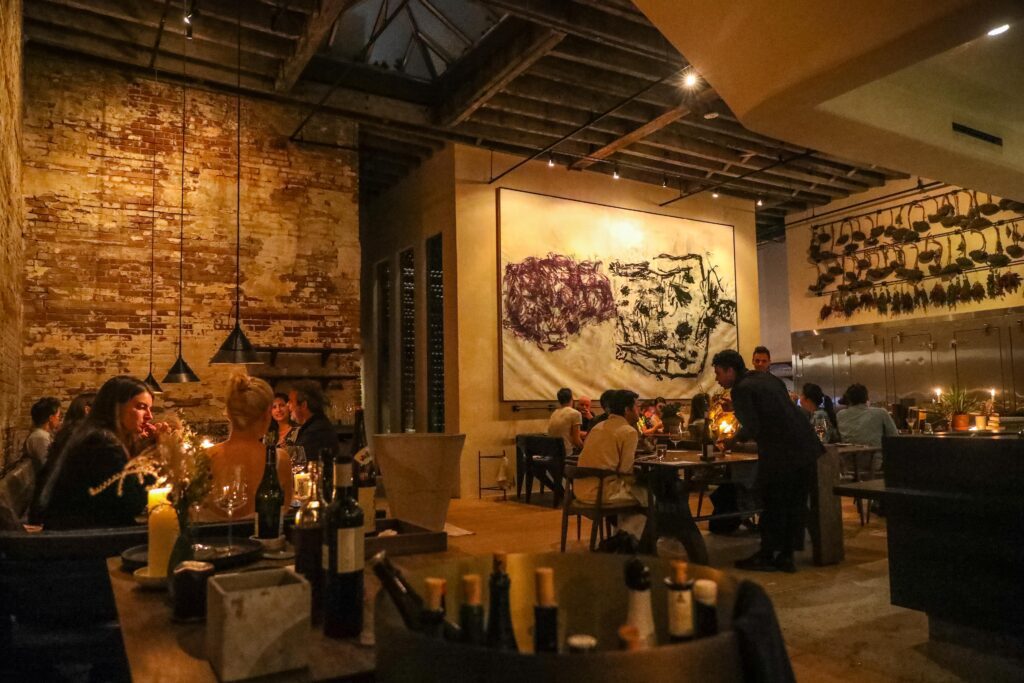
Scandinavian by design (Scott Lynch)
The ideas driving Ilis are unique and exciting on several levels, from the playful structure of the menu to the stunning design of the room to the radical organization of the staff, all of which adds to the sense of momentousness here. Plus and most important, based on a preview feast I was invited to this past weekend, the food at Ilis is simply phenomenal. One of the best, most giddy-making meals I’ve had in years.
There’s a lot to talk about here, but let’s start with the name. “Ilis” is a portmanteau, a combination the Danish words, “ild” and “is,” or fire and ice.
“I’ve always been really fascinated by fire. It’s like caveman stuff,” Refslund tells Brooklyn Magazine. “There’s something special about coming together around a fire, or having barbecue on Sundays. But after I started traveling a lot to Japan, and also Brazil where there’s also a huge sushi culture, there became more and more raw things that I liked. So I wanted to combine these two worlds. Fire and ice. Not by making Japanese sushi or American barbecue, but by making my style of food.”
As such, Refslund says, “the menu is not really like what you see at a normal restaurant.” It’s a sort of choose-your-own-adventure dining experience: Each base ingredient available that night — mushrooms, say, or eel, or beets, or bison — is given a page in a book that looks like some sort of vintage field guide, complete with line drawings. You choose which ingredients you want, and whether you want them blasted by the wood-burning fire roaring away in the kitchen or served cold.
We had the eel both ways, and both were very good. Served cold, the swimmer arrived as a delightfully fluffy mousse, with a small puddle of liquid horseradish on the side and a scattering of unripe blueberries, which our server said had been “caper-ized,” bringing even more bite to the dish. Coming in hot, the eel was charred and served with a marigold “brush,” which you can and should eat after you’ve used it to coat the fish with tare, a traditional Japanese glaze.
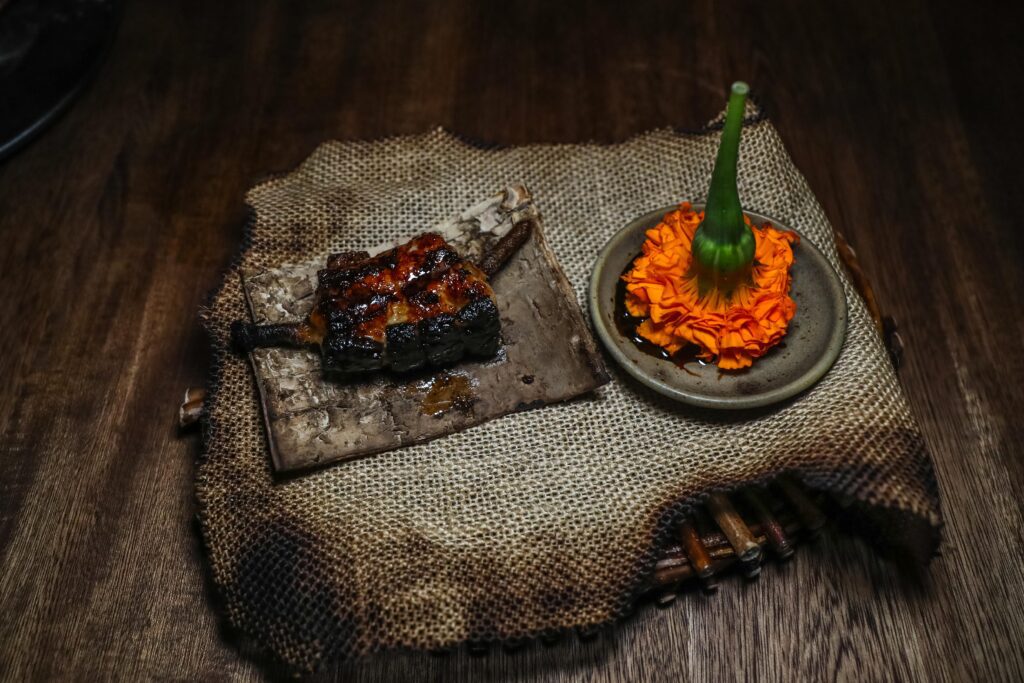

Barbecue eel with marigold glaze brush (Scott Lynch)
The raw big eye tuna was prepared as a dumpling of sorts, combined with salted plum inside nasturtium leaves. All the plating is lovely and dramatic at Ilis, but this may have been my favorite looking dish of the night, like the home of a tiny magical frog.
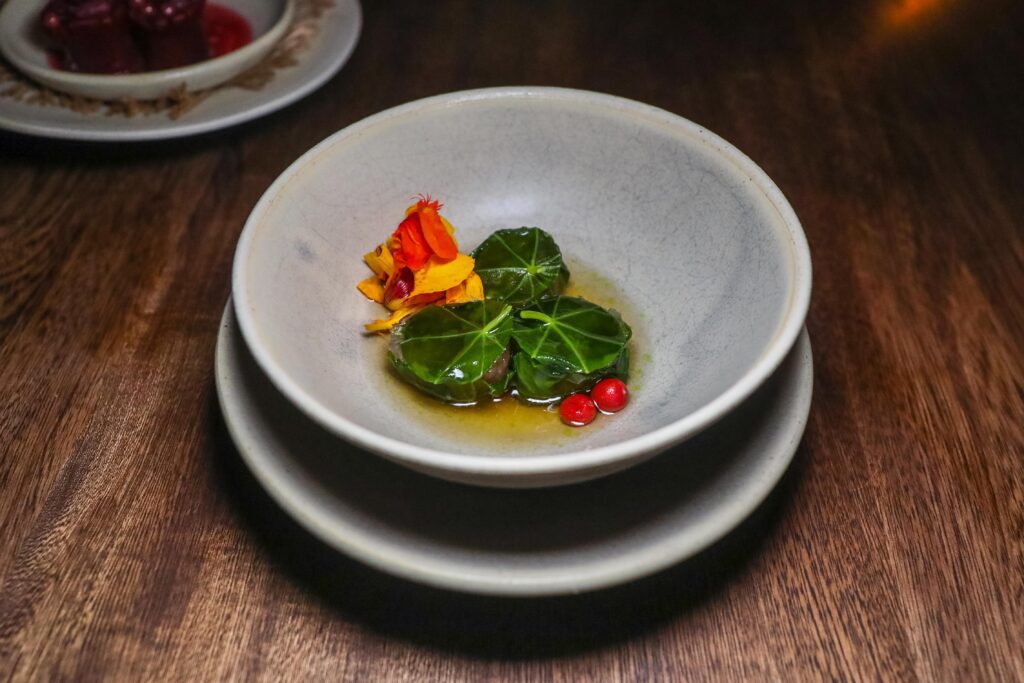

Big eye tuna with salted plum inside nasturtium leaves (Scott Lynch)
There was a plate of assorted grilled mushrooms, all perfect, and a bunch of raw matsutake slices sitting atop a blob of fresh cheese at the bottom of a “bowl” made from lotus leaves.
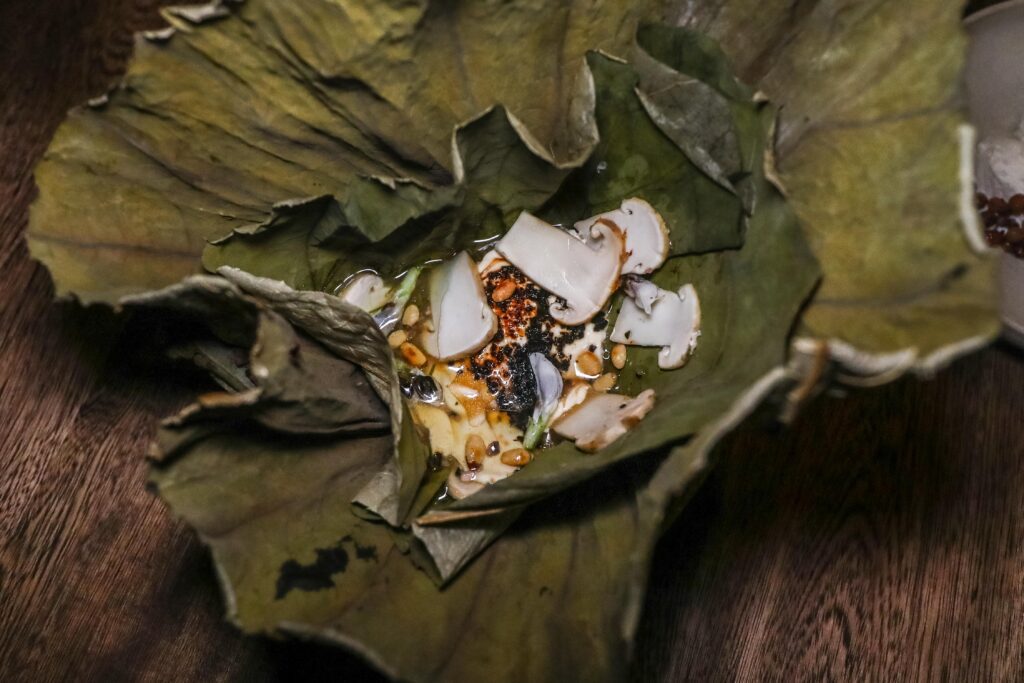

Raw matsutake mushroom with freshly made cheese (Scott Lynch)
The steamed scallop was enormous, redolent with seaweed, and delicious. The wild boar came as both a rib and a chop, sticky with salted cherry and black garlic. My favorite single bite of the night may have been the funky bison tartare, which was stuffed into little beets and sodden with a potent berry vinegar.
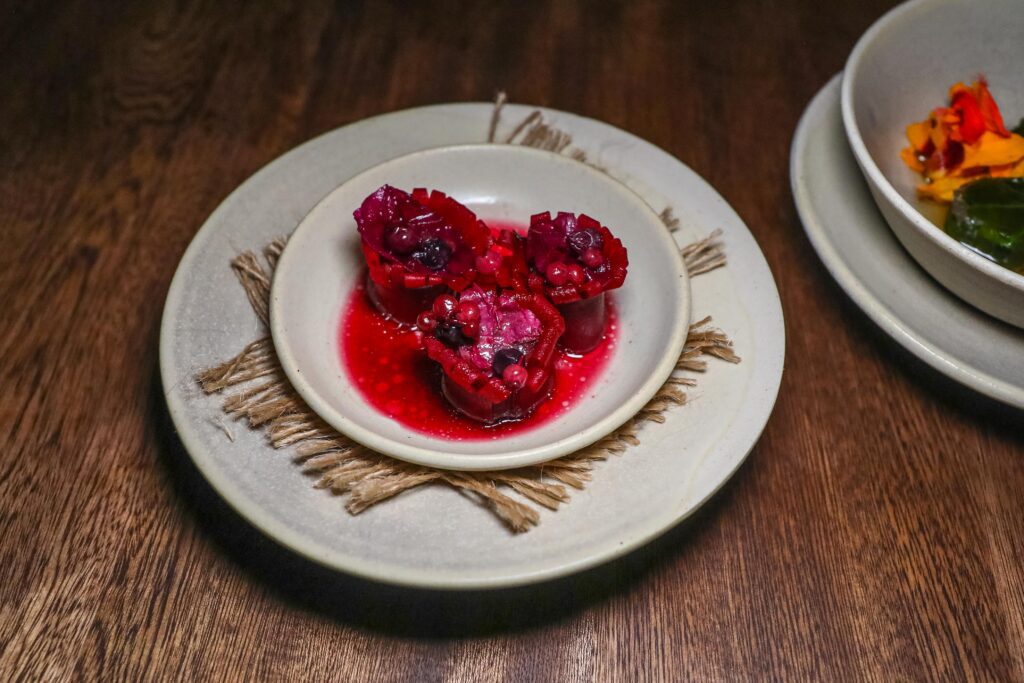

Bison tartare with beets and berry vinegar (Scott Lynch)
In addition to the menu items, there are also snack carts that make the rounds. At our preview dinner, these included a smoky clam and tomato drink served, hilariously, inside a giant shell, which had been split open, cleaned out, and resealed with beeswax, so it functioned like a flask. Oysters came topped with cucumber and almond or a squeeze of pineapple. And the raw scallop, sitting with with a strawberry, was amazing.
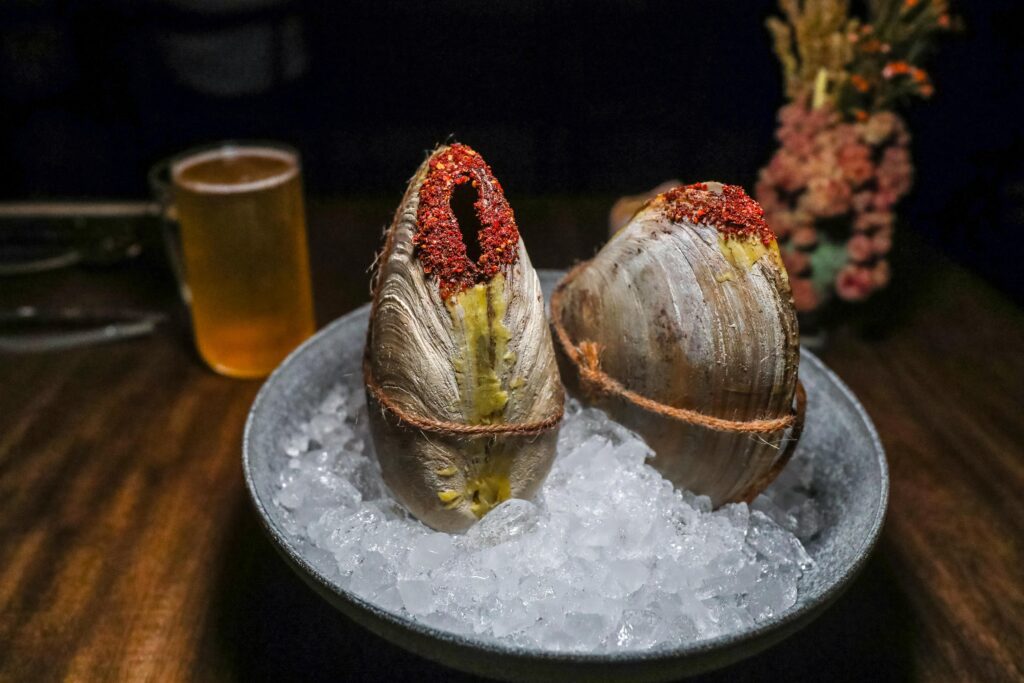

Surf clam and tomato cocktail, served in handy shell flask (Scott Lynch)
There were two main courses available at the preview dinner, designed to be shared by the table. We had the whole brown trout, fire roasted in birch bark (we were told later that this technique took a long time to perfect; many early attempts ended up in flames) and paired with a luxurious roe butter and an assortment of cabbage leaves. Possibly the best single fish I’ve ever had in my life.
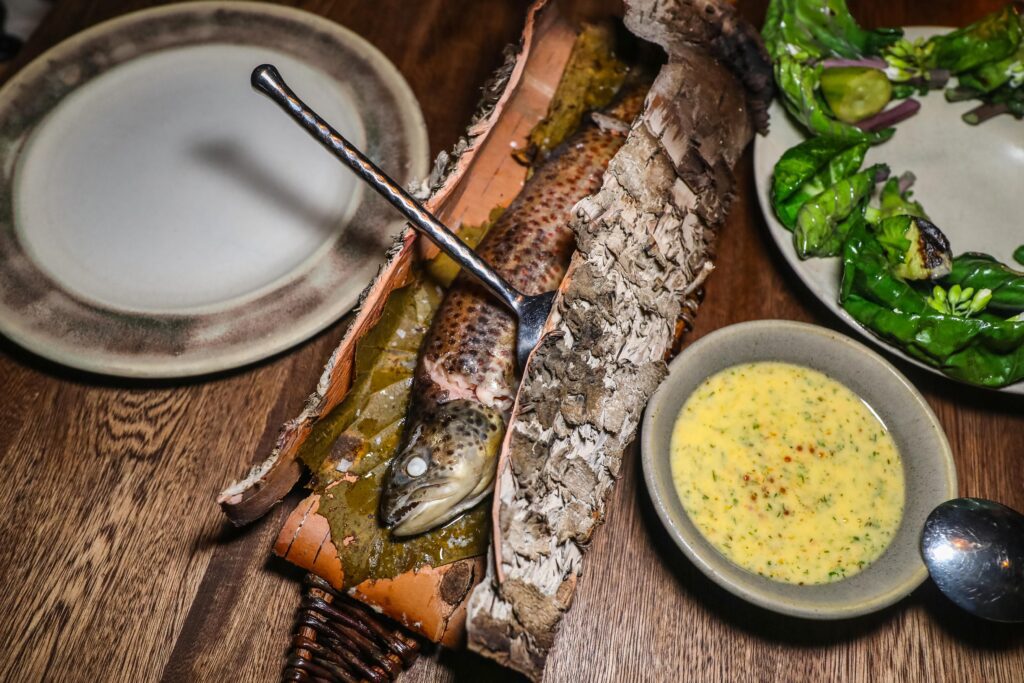

Fire roasted brown trout in birch bark with a bowl roe butter (Scott Lynch)
Our meal lasted about three hours, and that was fine by us. The room here is glorious, dominated by the huge 25′ x 35′ open kitchen in the center of everything, with bar seating, plush banquettes and four top tables surrounding the work area. Enormous paintings and a massive drying rack, from which hang sunflowers and chilis, bring warmth and color to the industrial space. There’s also a very Danish-looking lounge area along one wall. It’s an exceptionally pleasant and comfortable place to hang out.
The unusual layout serves another purpose as well. “I didn’t want to create a restaurant,” Refslund says. “I wanted to create a kitchen, with the dining room and bar added to the space afterward, because for me Ilis has always been about having a ‘one house’ team, where we are all a part of something united.”
In other words, except for the sommeliers and a couple of managers, there’s no distinction between front of house and back of house here. “One house” means that your servers and bussers are also your chefs, with half of the kitchen crew interacting with the guests for two weeks, then switching with the other half. This arrangement not only allowed Refslund to hire “as many cooks as we needed in the kitchen” (and there are a lot of bodies bustling around in there); it also made everyone eligible for the tip pool, so everyone earns an equitable wage.
A handful of restaurants around town have used this model before, notably Patricia Howard and Ed Szymanski’s Dame in the West Village, but not on this scale. Refslund’s business partner Will Douillet, a longtime hospitality pro, is in charge of teaching the cooks how to handle both sides of the line, and my prediction is they’ll be able to pull it off. At our dinner, the service was delightful. The chefs know the food inside and out, of course, and they bring an endearing informality to the proceedings, a welcome change from the stiff obsequiousness you sometimes get at high-end restaurants.
“I’m lucky to have all these amazing people in the kitchen,” says Refslund. “There’s a really good spirit here right now. You can feel the energy. The people want to be here. It’s the first time in a long long time I have felt that energy in the kitchen, so I’m very happy where we are right now.”
The exact pricing hasn’t been set yet, but Ilis will certainly be a very expensive place to eat, especially if you start playing around with the 1,000-bottle wine list. Dinner starts with a five-course minimum in the dining room, with an abbreviated a la carte menu available at the bar and in the lounge area. Cocktails hover around $20. Refslund expects to launch a more casual (and cheaper) family-style Sunday service later this fall, which will be for walk-ins only.
Ilis is located at 150 Green Street, just west of Manhattan Avenue, and is currently open on Wednesday through Saturday from 5:30 p.m. to midnight. Sunday service, when it kicks off, will run from noon to 7 p.m.
You might also like 

















